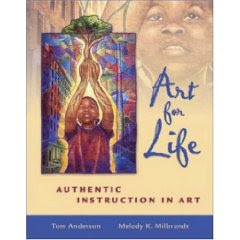Joni
H. Hough
November
1, 2013
Advanced
Art Education Methods
Review of Duncum
In the article, “Breaking Down the Alleged
‘U’ Curve of Artistic Development,” Duncum argues against using Gardner’s “U”
curve theory in judging the artwork of children in middle childhood. Duncum instead proposes a straight line
theory to explain children’s artistic development. My experience working with children in middle
childhood is more aligned with Duncum’s straight line theory than Gardner’s “U”
curve theory.
Duncum begins by explaining that the
“U” curve represents early childhood as the first point on the “U.” Adolescents is represented as the second
point. The middle signifies the decline
in development that accompanies middle childhood.
One problem with Gardner’s “U” curve
theory is that the “experts” have difficulty determining the age of decline,
with it ranging from as young as five and as old as fourteen years old. Duncum’s line theory signifies change with a
jagged, diagonal line that accounts for the range of ages at which children
develop.
Duncum further argues that the
“decline in quality” of drawings from middle childhood is a judgment based on
stylistic preferences. This may be due
to the psychologist lack of art expertise.
I agree with Duncum on this point because I see value in the work of
children in middle childhood. Duncum
offers several alternative models of viewing the drawings of middle childhood
including the artist as craft person and viewing the work as graphic
development.
Because Gardner describes the time
of middle childhood as a time when children acquire greater skills in
artmaking, Duncum questions why this time is then considered the trough of the
“U” curve. Duncum also questions why
Gardner is judging the product when, as a psychologist, he is concerned with
the process. I agree with Duncum on this
point. Gardner should not be focused on
the product.
According the Duncum, Gardner looked
at seven conditions of artmaking: “(a) a
playful exploration of forms, leading to (b) the intentional (c) communication
of (d) subjective knowledge which (e) is worthy of social attention (f) by
means of aesthetically pleasing object (g) fashioned by learned skill”
(74). According to Gardner all of these
conditions can only be met by an adolescent, stating that only in adolescents
is artwork worthy of social attention. I
believe that children’s artwork is worthy of social attention regardless the
age of the artist. Artworks created in
early and middle childhood are just as worthy of social attention as those from
adolescents. Further, Duncum points out
that some middle-childhood-aged children can produce work that even Gardener
would consider worthy of social attention.
Finally, Duncum proposes his own
model of child development. His model is
a straight line, showing all developmental stages are equally important. This model also shows the breaks between early
childhood, middle childhood, and adolescents as jagged and tapered showing that
the transitions between stages is gradual and uneven. This model is more aligned with my
experiences with middle childhood artists.






No comments:
Post a Comment